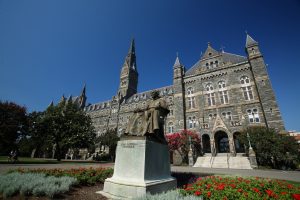To the editors,
I read with great interest your January 11, 2007 editorial, “Making Student Loans Easy.” It encourages Congress to provide more money for student financial aid and suggests that the Federal Direct Lending Program (DL) is a better method for providing loans than the Federal Family Education Loan Program (FFELP) used by Georgetown. On your first point, I could not agree with you more. Federal funding is a key ingredient in our “meeting full need” policy, and we fully support increasing the Pell grant annual maximum. Administering federal student loans is much more complex. I applaud your desire to “Make Student Loans Easy”; however, lending is by its very nature much more complicated. There are two federal student loan programs: FFELP, established in 1965, is a public-private partnership that leverages private funds loaned to students by private, nonprofit and state-based organizations, DL, created in 1993, is a program administered by the U.S. Department of Education that uses U.S. Treasury funds to provide loans to borrowers.
Schools can select between FFELP and DL. Over 80 percent of schools use FFELP. There have been recent claims that private universities benefit financially from the “incentives” offered by private lenders. The only “incentives” offered by the private lenders we work with are “borrower benefits” for students. Samples of these benefits are:
sThrough FFELP, the typical Georgetown undergraduate student can save $1,703 over a standard 10-year repayment term, compared to the $859 in savings offered to DL borrowers.
sThrough FFELP, a typical Georgetown graduate student using the new Federal Graduate-PLUS loan can save $5,921 over a standard 10-year term, compared to the $1,938 in savings under DL.
sA typical Georgetown parent borrower can save $1,306 over 10 years using FFELP, compared to $459 in savings in DL.
This is because FFELP lenders offer Georgetown students borrower benefits that are not available in DL. While some schools have found that the DL program meets their needs, we decided not to implement it for Georgetown students because it could cost them thousands of dollars in higher fees and deny them the borrower benefits offered through FFELP.
There are other important reasons why Georgetown has not moved to DL. In FFELP, competition among FFELP lenders not only results in reduced loan costs each year for students but also prompts constant improvements in the loan delivery systems and supplemental services offered to borrowers. This helps borrowers minimize repayment difficulties and guarantees that lenders provide exceptional customer service for the entire life of the loan, which is sometimes as long as 30 years. We work with lenders who have a proven track record. We monitor them closely and remind them that if we are not happy with their products and services, they will be replaced with a more responsive lender.
The bottom line is that it costs money to administer student loans either through FFELP or DL. It is not an easy process either way. With FFELP, the lender absorbs the administrative cost. With DL, much of that cost falls to the University. We believe that our partnership with our FFELP lenders allows us to deliver these very important student loan funds in the manner most economical to our students and to Georgetown.
Patricia McWade
Dean, Student Financial Services
Georgetown University




